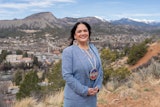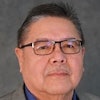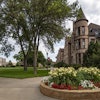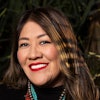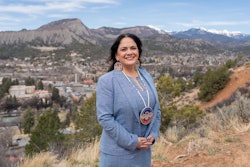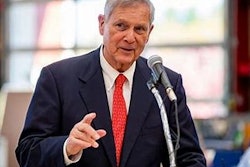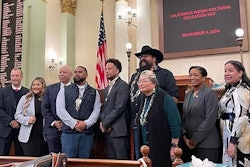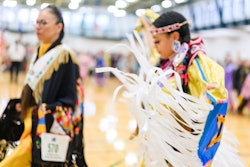Unable to sleep one night, Dustin Morrow was scrolling through the usual blur of posts and advertisements on Facebook when a commercial for the University of Minnesota caught his eye — and held it for ten minutes. The video was entirely in Ojibwe, the language his ancestors had spoken for centuries.
Then a recent graduate from the Lac Courte Oreilles Ojibwe Community College in Wisconsin, Morrow is now a junior at the University of Minnesota Twin Cities. As an enrolled member of the Lac Courte Oreilles tribe, he’s among a community of Native Americans at the school that has experienced a significant rise in enrollment and retention within the past decade.
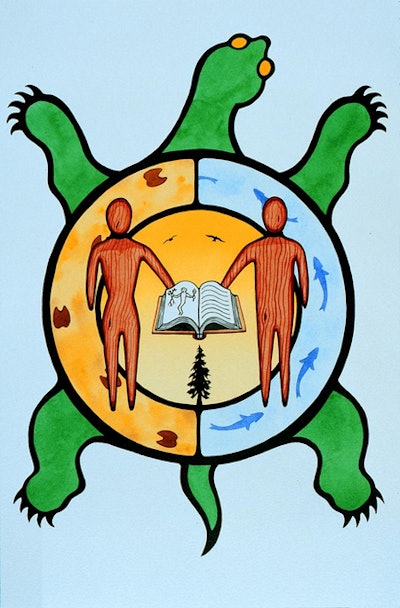
What’s more, all this happened as the University of Minnesota’s general admissions rate, like so many other schools across the nation, had been declining since 2005, begging the question: What changed?
Bridging Cultures
According to Postsecondary National Policy Institute data, while 60% of the U.S. population pursues higher education after high school, only 17% of Native Americans continue onward, meaning they remain among the most underrepresented groups in higher education — the reasons, for which, remain various and complex. For instance, Native Americans are statistically more likely to attend low-performing high schools, more likely to be first-generation students and more likely to qualify for financial assistance than White students.
Additionally, they face barriers that remain difficult to quantify, such as familial obligations, a historical distrust of federal institutions, imposter syndrome and cultural isolation.
According to Dr. David Chang, chair of University of Minnesota Twin Cities’ Department of American Indian Studies and a professor of history, cultural isolation remains one of the largest reasons Native college students leave school and return home.
“Colleges need to demonstrate that they understand that people
come from communities, are committed to their communities, want to remain connected to their communities and that universities are not there to take them away from that,” says Chang. “They need to feel they aren’t leaving who they are if they decide to come here.”
To that end, celebrating Native culture and building indigenous community on campus cannot be overstated at the school. In the past decade, Chang says the school has “doubled and dedicated” its resources to doing just that through organizations such as the Circle of Indigenous Nations, or COIN.
Whether it’s walking students through the complex world of indigenous scholarships or providing mentors through a weekly elders-in-residence program, COIN supports Native Americans in all aspects of their academic and personal lives.
 Dr. David Chang
Dr. David ChangIn tandem with the school’s American Indian Student Cultural Center and American Indian Culture House (a co-ed residence hall), it also provides an extensive list of community and culture-oriented programs, such as organizing “Frybread Fridays,” special speakers series and religious ceremonies throughout the year. Come April, Native students will participate in the annual spring powwow.
“When I first came up here, they were in the middle of a pipe ceremony,” said Morrow. “And you could smell that sage and that smoke in the air from the blessings. It just brought me home and made me feel more grounded, and I was like ‘alright, I can do this.’”
The pull of home
Building indigenous community not only reduces isolation and imposter syndrome, but comforts those who feel guilty for leaving their communities. And for many Native students, that guilt is tangible.
“The guilt of leaving your family takes a huge toll, and that’s what I’ve experienced in my work and in knowing why many American Indians don’t stay. It’s because of family obligations and ceremony obligations,” says COIN interim coordinator Raul Aguilar Jr.
An enrolled member of the Red Lake Nation, Aguilar was once himself a student at the university and has first-hand understanding of the homesickness Native students can feel.
“I remember the conversations with my grandma when she’d ask, ‘Raul, why do you want to go so far away from home? You know your mom is sick,’” said Aguilar, who lost his mother, grandmother and grandfather while away at school.
Couple that grief with frequent questions from family and friends such as, “You’re coming back, right?” or “Are you going to help the community here?” and, soon, returning home feels more pertinent than midterm exams.
Morrow listened as Aguilar shared his story of leaving home before softly adding: “It felt like you were talking about me.”
“It seems like every time you turn around, you’re losing someone else,” Morrow says. “So that was a huge reason why I didn’t want to leave. I didn’t want to lose any time with any family, and I didn’t really know how to come to terms with that.”
Before Minnesota, Morrow tried the university route before, years
 Raul Aguilar Jr.
Raul Aguilar Jr.earlier. With his car packed for school, Morrow first attended his uncle’s funeral before driving himself to the University of Wisconsin the same day, leaving his family’s ceremonies in the rearview mirror. That semester, amid other reasons, he returned home.
For those who don’t grow up in Native communities, understanding the frequency of funerals can be challenging. That’s where people like Morrow and Tadd Johnson, professor of American Indian studies at the University of Minnesota Duluth, step in.
“It’s possible a non-Indian professor may not understand Native American students as well, and they might say, ‘How many funerals can there possibly be?”’ says Johnson. “Having lived on the reservation, I know they happen a lot and, frequently, the entire community goes.”
Educating faculty and staff about their students’ situations is often part of Johnson and Aguilar’s job.
“They’re very accommodating when I explain to them that it takes a little time, that ceremonies can take time,” says Aguilar. “We just have to be able to make sure that we’re all in this so our students can be successful, even when things come up.”
Tribal relations
When Aguilar first began working in the University of Minnesota Twin Cities Office of Admissions, he occasionally traveled to national diversity and equity conferences, where, in those crowds, he realized how rare his position was. He was often the only recruitment officer solely dedicated to American Indian services.
With Native Americans constituting only 1% of the U.S. population, it’s not uncommon for schools to group them with other minority groups — whether that’s Hispanic, Black, Latinx or Asian. But there’s a slight problem with “cramming” Native American students into solely a racial category, says Johnson.
“People forget that being an Indian is not a racial classification; it’s a political classification,” says Johnson. “Being an Indian means being part of a sovereign nation. It’s a political classification under the federal law. So, that attachment to the community is written into the law, and it’s also a deeply felt connection that students have, and we have to understand that.”
An enrolled member of the Minnesota Chippewa Tribe, Johnson recently accepted an additional post as the first senior director of American Indian Tribal Nations Relations for the University of Minnesota system.
In that role, Johnson sees himself as a “liaison” who opens channels of communication between university officials and tribal governments. Having been a tribal attorney for more than 20 years, Johnson holds plenty of experience in government-to-government communication. And as the director of the master of tribal administration and governance program at the Duluth campus, Johnson frequently consults with tribes when developing new curriculum for the program.
“The federal government has been doing tribal consultations since the 1970s, and recently, the previous Governor [Mark Dayton] started requiring some other agencies to consult with tribes too,” says Johnson. “So, it’s ironic that the university, which is supposed to be the thought leader, is just catching up with the federal and state government.”
A Reflective Curriculum
The University of Minnesota’s American Indian Studies Department is the oldest program of its kind in the nation. Created in 1969, shortly after the American Indian Movement’s birth in Minneapolis, the program celebrated its 50th anniversary last year. During those years, the department’s principles have rippled throughout the university.
 Dr. Tadd Johnson
Dr. Tadd Johnson“They [the department] have really transformed the landscape,” says Aguilar. “Folks don’t realize that it really goes across every single college here, from landscape to forestry, from environmental science to history and archeology. The American Indian Department is involved in all aspects of this institution and the faculty have done a lot of great research.”
The department takes a multidisciplinary approach to its curriculum, integrating American Indian perspectives into courses that touch upon literature, fine arts, history, political science and philosophy.
Student groups on campus reflect this multidisciplinary approach also. There’s the American Indian Science and Engineering Society (AISES), which “bridges science and technology with traditional Native values,” and Canoe Rising, an outdoors group, which spreads awareness of global indigenous environmental struggles.
Some of the American Indian Department’s strongest programs, though, have been its Dakota and Ojibwe language majors.
“The language departments have been really important in terms of creating a site of identification and community,” says Chang.
Morrow, who is passionate about the spoken word, is majoring in Ojibwe, and this fall, he’ll participate in the new Ojibwe immersion house. Long before he arrived at the university though, Morrow had always been certain about one thing, stating, “I don’t want to be complicit in the erasure of my people’s culture.”
This article originally appeared in the April 2, 2020 edition of Diverse. You can find it here.
